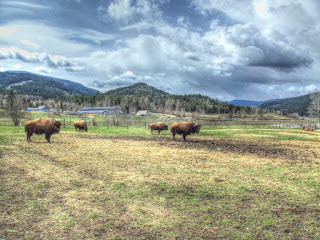Gail Anderson-Dargatz, The Spawning Grounds (again)
At this year's BC Studies conference last month in Kamloops, I said roughly this about Gail Anderson-Dargatz' Shuswap novels:
When I first read Turtle Valley a decade ago, when it was published, I was unkind: "Turtle Valley is one of my home places--primal landscapes, I think Don Gayton calls them--and Turtle Valley gets it wrong." When I read The Spawning Grounds on its publication a few years ago, I was harsher.
But overall, the politics of the novels makes sense to me, and when I look around at the Shuswap, in general I want to be able to rely on her politics in thinking through how to understand the place (and how to live there, though I don't imagine I'll ever be so fortunate again). Her representation of settler history and settler-Indigenous history in The Spawning Grounds should, for example, offer intriguing tools for considering the current stalemate / debacle around the spreading of biosolids in Turtle Valley.
What I wanted to be able to do was to read these books again, make peace with them, and have them help me respond to what I'm seeing in the wider world as well as the hyperlocal places I know best.
And before re-reading The Spawning Grounds this week, the scorecard read (1) love the place where the book's set, and (2) appreciate the books' politics, but (3) can't appreciate the books enough that I can integrate them into how I think about the world generally, and certainly not about the specific places she's writing about.
Still there, stupidly. I'm small-minded, I know, in my wanting this novel to be accurate to its place as well as politically sensitive and philosophically rich and engaging as a work of art, and in my deep need for the first condition.
Very well, I'm small-minded. In the language from my BC Studies talk, I'm still resisting.
Here are some of her interviews about the novel. Tell me I'm wrong:
"Somehow I've never forgiven Gail Anderson-Dargatz for her novel Turtle Valley, whose topography made no sense to me even though her characters felt wonderfully knowable.... I needed her novels to be more representative, more evocative, of the place I knew. As unreasonably cranky as I continue to feel about these novels, though, and believe me when I say that I've got some complaints, I don't think I can keep resisting them."I say "roughly" because that's what my script read, but I'm confident that I ad-libbed and/or flubbed that bit. It's not a comfortable discussion, and I'm struggling to think my way through the problem I've found myself in with her novels.
 |
| Turtle Valley Bison Ranch, improbably |
When I first read Turtle Valley a decade ago, when it was published, I was unkind: "Turtle Valley is one of my home places--primal landscapes, I think Don Gayton calls them--and Turtle Valley gets it wrong." When I read The Spawning Grounds on its publication a few years ago, I was harsher.
But overall, the politics of the novels makes sense to me, and when I look around at the Shuswap, in general I want to be able to rely on her politics in thinking through how to understand the place (and how to live there, though I don't imagine I'll ever be so fortunate again). Her representation of settler history and settler-Indigenous history in The Spawning Grounds should, for example, offer intriguing tools for considering the current stalemate / debacle around the spreading of biosolids in Turtle Valley.
What I wanted to be able to do was to read these books again, make peace with them, and have them help me respond to what I'm seeing in the wider world as well as the hyperlocal places I know best.
And before re-reading The Spawning Grounds this week, the scorecard read (1) love the place where the book's set, and (2) appreciate the books' politics, but (3) can't appreciate the books enough that I can integrate them into how I think about the world generally, and certainly not about the specific places she's writing about.
Still there, stupidly. I'm small-minded, I know, in my wanting this novel to be accurate to its place as well as politically sensitive and philosophically rich and engaging as a work of art, and in my deep need for the first condition.
Very well, I'm small-minded. In the language from my BC Studies talk, I'm still resisting.
Here are some of her interviews about the novel. Tell me I'm wrong:
- the Edmonton Journal (Q1: "As a white woman, do you feel comfortable working with native lore?" A1, partly: "... if we let other people tell us we can't write from historical stories or another culture's, or even our personal stories ... it's a mistake to listen to that.")
- Zoomer ("If you're going to write fiction, you have to mess with the landscape.")
- the Vernon Morning Star: "Anderson-Dargatz says those looking for familiar Shuswap locations, or particular pathways, in the novel should give up trying."
- her own blog: "as the locals will undoubtedly tell you, the landscape in my books is very much an imagined one."
Comments